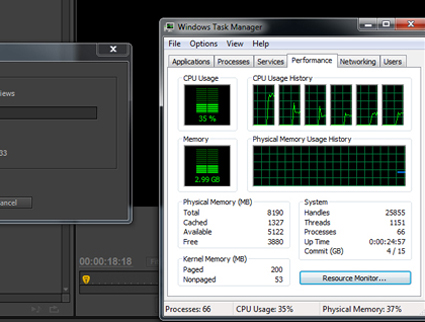Review: Magic Bullet Denoiser II
Magic Bullet Denoiser II is the latest version of Red Giant's popular plug-in for removing video noise from troublesome footage. Event and documentary filmmaker tests the plug-in on two different clips and shows before-and-after results and assesses Denoiser's usability, effectiveness, and rendering speed.
Denoiser II Rendering Times
So what about rendering times? If you use Red Giant software, especially Magic Bullet, you won't expect this plug-in to be real time, and you'll be right. Although it is inevitable that a process like this takes time, I can't ignore the fact that it limits the appeal of the software. Granted, the test edit suites used might not be the newest and fastest, but neither are they the slowest a production company might use.
A quick look at the system resource monitor reveals that the render is using only 30-40% of the available processing power (Figure 4, below), suggesting that either the code isn't completely optimized for multi-threaded computing, or the math behind it prevents it from taking advantage of the full processing capabilities of my six-core system and Cuda card. Whatever the reason behind it, at least for me, this relegates the plug-in to my "open in case of an emergency only" toolbox.

Figure 4. During rendering, the system resource monitor shows that the render is using only 30-40% of my system's processing power, which suggests that better optimization could accelerate the process.
On AVCHD footage 1920x1080 at 25fps (I'm a UK-based PAL user), 40 seconds of dance footage took a whopping 38 minutes to render with the standard settings. Although I love a coffee break, it wouldn't take me long to overdose on coffee at that rate.
In Conclusion
In conclusion, although the results of Denoiser II can be quite impressive, the long render times limit its appeal. Even adjusting settings in the plug-in often resulted in a temporary unresponsiveness of the system.
Putting aside these issues, Denoiser II definitely improves footage that would otherwise have been unusable. Unlike some other products I've worked with, I found that the default settings presented to the user in Denoiser are often usable without the need of further adjustment.
As I mentioned at the start, nothing beats getting things right at the time of shooting. Denoiser II is not designed to be used on each clip of a project, but is there to save a shot if needed, and it does so as advertised. I just wish it did it a little faster.
Related Articles
A look at Magic Bullet's Denoiser III video noise reduction plug-in
In this tutorial, Jan Ozer demonstrates how you can use the Neat Video plug-in to remove noise from video, improving output quality for all outputs.